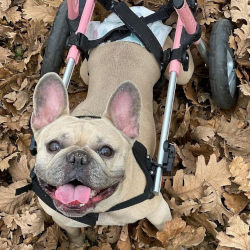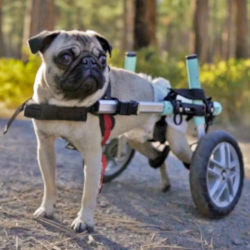What is Incontinence?

Incontinence is when a dog cannot control their bowels and bladder. This can happen to an older dog who was previously house-trained, a dog that has become paralyzed and no longer has control over those muscles, or just a symptom of a UTI (urinary tract infection). The severity of incontinence can range from occasional small urine leaks to inadvertent voiding of large amounts of urine.
Canine incontinence most commonly occurs in female, spayed dogs, but is quite common in dogs with neurological problems, spinal conditions, or those that are paralyzed.
Is Incontinence in Dogs Curable?
Incontinence is typically a symptom of other illnesses. For example, while a UTI is an entirely curable illness with the proper medications, incontinence from paralysis is something you and your dog will likely have to manage for the rest of your pet’s life.
What You Need to Manage Your Dog’s Incontinence
While incontinence might seem like the end of the world, you can manage your pup’s incontinence with just a few extra supplies.
Dog Diapers and Male Wraps

Males Wraps wrap around your male dog’s genitals and back to keep urine off of your surfaces, and just like having a baby diaper for dogs, will keep the urine and feces contained while your dog goes about their life. In addition, a male wrap is an excellent solution for boy dogs with frequent urine leaks.
Tip: Dogs wearing diapers need to be changed and cleaned frequently to avoid urine burns and skin irritation!
Pee Pads
Pee pads are easy to put under your incontinent pup while hanging out on surfaces that aren’t as easy to clean as your couch or car seats. Simply place a pee pad under your dog when they’re resting to prevent leaks and keep your house clean. The pee pads will allow you to protect your furniture and keep your pup close!
Cleaning Supplies
Accidents are bound to happen with urine incontinence, so having cleaning supplies you trust on hand is a must! Looking into an enzymatic cleaner that can break down the proteins in the urine, so your pup doesn’t keep returning to the same areas to pee, thinking that is the right spot to do their business
Easy to Clean Beds/ Bedding
Elevated beds designed for incontinent pets are great as they wipe down quickly, and the urine falls through the perforations so your dog isn’t lying in their pee which can cause painful skin irritation.
While we of course, want our pets to have the most comfy bedding, consider how often you will have to change and wash it. Towels and fleece blankets are easy to clean. They will keep your pup cozy and comfy but will hold up to frequent washing.
How to Express Your Dog’s Bladder

Knowing how to express your dog’s bladder can significantly reduce the number of in house accidents and allow your pup to empty its bladder fully, thus reducing the risk of UTIs. Expressing is the manual external process of helping your dog empty its bladder.
Place your hands on the pet’s sides behind the rib cage and apply even, steady pressure squeezing inward and upward. Be careful not to put any pressure on your dog’s spine while squeezing. As your pup’s bladder empties, you can feel it shrink and empty. You should express your dog’s bladder around every 6 hours.
It is essential to express in the same general location and use the same command every time, just like when you house-trained your dog. This allows your dog to know it’s ok to relax its bladder. The bladder needs to be emptied regularly to avoid serious complications. An unexpressed bladder can lead to bladder and urinary tract infections that can be painful. Untreated, an infection can even spread to a dog’s kidney. If a pet has not peed in 24 hours and you are unable to express the bladder, your pet needs emergency care.
Here is a great video explaining how to express your dog’s bladder from Super Scooty, the happiest dog on the planet!
